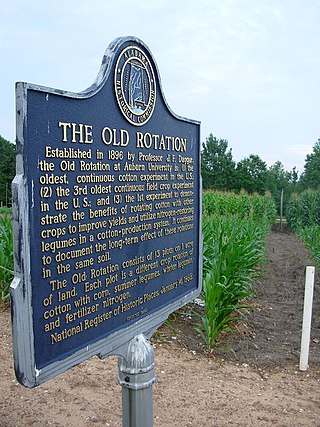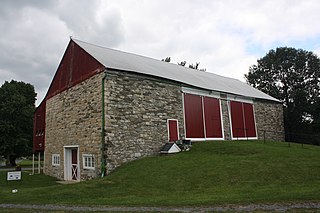
Crop rotation is the practice of growing a series of different types of crops in the same area across a sequence of growing seasons. This practice reduces the reliance of crops on one set of nutrients, pest and weed pressure, along with the probability of developing resistant pests and weeds.

In agriculture, a green manure is a crop specifically cultivated to be incorporated into the soil while still green. Typically, the green manure's biomass is incorporated with a plow or disk, as is often done with (brown) manure. The primary goal is to add organic matter to the soil for its benefits. Green manuring is often used with legume crops to add nitrogen to the soil for following crops, especially in organic farming, but is also used in conventional farming.

Sir John Bennet Lawes, 1st Baronet, FRS was an English entrepreneur and agricultural scientist. He founded an experimental farm at his home at Rothamsted Manor that eventually became Rothamsted Research, where he developed a superphosphate that would mark the beginnings of the chemical fertilizer industry.

Nutrient management is the science and practice directed to link soil, crop, weather, and hydrologic factors with cultural, irrigation, and soil and water conservation practices to achieve optimal nutrient use efficiency, crop yields, crop quality, and economic returns, while reducing off-site transport of nutrients (fertilizer) that may impact the environment. It involves matching a specific field soil, climate, and crop management conditions to rate, source, timing, and place of nutrient application.

Agricultural wastewater treatment is a farm management agenda for controlling pollution from confined animal operations and from surface runoff that may be contaminated by chemicals in fertilizer, pesticides, animal slurry, crop residues or irrigation water. Agricultural wastewater treatment is required for continuous confined animal operations like milk and egg production. It may be performed in plants using mechanized treatment units similar to those used for industrial wastewater. Where land is available for ponds, settling basins and facultative lagoons may have lower operational costs for seasonal use conditions from breeding or harvest cycles. Animal slurries are usually treated by containment in anaerobic lagoons before disposal by spray or trickle application to grassland. Constructed wetlands are sometimes used to facilitate treatment of animal wastes.

Organic horticulture is the science and art of growing fruits, vegetables, flowers, or ornamental plants by following the essential principles of organic agriculture in soil building and conservation, pest management, and heirloom variety preservation.
A long-term experiment is an experimental procedure that runs through a long period of time, in order to test a hypothesis or observe a phenomenon that takes place at an extremely slow rate. What duration is considered "long" depends on the academic discipline. For example, several agricultural field experiments have run for more than 100 years, but much shorter experiments may qualify as "long-term" in other disciplines. An experiment is "a set of actions and observations", implying that one or more treatments is imposed on the system under study. Long-term experiments therefore contrast with nonexperimental long-term studies in which manipulation of the system studied is impossible or undesirable.

The Cullars Rotation is a soil fertility experiment on the Auburn University campus in Auburn, Alabama and is listed on the National Register of Historic Places. The Cullars Rotation experiment, which started in 1911, is the oldest ongoing cotton fertility experiment in the United States, the oldest soil fertility experiment in the Southern United States, and the second oldest continuous cotton experiment in the world.

The Old Rotation is a soil fertility experiment on the Auburn University campus in Auburn, Alabama. The Old Rotation experiment, which started in 1896, is the third-oldest ongoing field crop experiment in the United States and the oldest continuous cotton experiment in the world. It was the first experiment to show that a cotton/legume crop rotation would allow soil to support a cotton crop indefinitely. The Old Rotation is listed on the National Register of Historic Places.

The Morrow Plots is an experimental agricultural field at the University of Illinois Urbana-Champaign. Named for Professor George E. Morrow, it is the oldest such field in the United States and the second oldest in the world. It was established in 1876 as the first experimental corn field at an American college and continues to be used today, although with three plots of much reduced size, instead of the original ten half-acre lots. The site was designated a National Historic Landmark on May 23, 1968. The fields are managed by the College of Agricultural, Consumer, and Environmental Sciences.

The Robert A. Millikan House is a historic house at 5605 South Woodlawn Avenue in the Hyde Park community area of Chicago, Illinois, Built about 1907, it was from about 1908 until 1921 the home of American physicist Robert A. Millikan (1868-1953), the period in which he made his most significant Nobel Prize winning work. The three-story brick building earned National Historic Landmark status on May 11, 1976.

The Connecticut Agricultural Experiment Station (CAES) is the Connecticut state government's agricultural experiment station, a state government component that engages in scientific research and public outreach in agriculture and related fields. It is the oldest state experiment station in the United States, having been founded in 1875. Its official mission is to "develop, advance, and disseminate scientific knowledge, improve agricultural productivity and environmental quality, protect plants, and enhance human health and well-being through research for the benefit of Connecticut residents and the nation." The station operates a main research campus in New Haven, a research farm in Hamden, a satellite research facility and farm in Windsor, and a research farm in Griswold. The Storrs Agricultural Experiment Station is a separate agricultural research agency, founded in 1887 and part of the University of Connecticut, which also receives state and federal funding.
This is an incomplete list of historic properties and districts at United States colleges and universities that are listed on the National Register of Historic Places (NRHP). This includes National Historic Landmarks (NHLs) and other National Register of Historic Places listings. It includes listings at current and former educational institutions.

The University of Wisconsin Dairy Barn is a building located on the campus of the University of Wisconsin–Madison. Built in 1897, the building played an important role in the field of dairy science during the 20th century. It has been used both as a teaching facility and as a site for agricultural research. It is significant for its association with the single-grain experiment, performed from 1907 to 1911 by Stephen Babcock. The UW Dairy Barn was declared a National Historic Landmark in 2005.
The Edmund Ruffin Plantation, also known as Marlbourne, is a U.S. National Historic Landmark in Hanover County, Virginia, 11 miles (18 km) northeast of Richmond.

Rodale Institute is a non-profit organization that supports research into organic farming. It was founded in Emmaus, Pennsylvania in 1947 by J. I. Rodale, an organic living entrepreneur. After J.I. Rodale died in 1971, his son Robert Rodale purchased 333 acres and moved the farm to Kutztown, Pennsylvania.

Agricultural pollution refers to biotic and abiotic byproducts of farming practices that result in contamination or degradation of the environment and surrounding ecosystems, and/or cause injury to humans and their economic interests. The pollution may come from a variety of sources, ranging from point source water pollution to more diffuse, landscape-level causes, also known as non-point source pollution and air pollution. Once in the environment these pollutants can have both direct effects in surrounding ecosystems, i.e. killing local wildlife or contaminating drinking water, and downstream effects such as dead zones caused by agricultural runoff is concentrated in large water bodies.

William Penn Brooks was an American agricultural scientist, who worked as a foreign advisor in Meiji period Japan during the colonization project for Hokkaidō. He was the eighth president of the Massachusetts Agricultural College. Brooks is remembered as one of six Founders of Phi Sigma Kappa fraternity in 1873.

The history of fertilizer has largely shaped political, economic, and social circumstances in their traditional uses. Subsequently, there has been a radical reshaping of environmental conditions following the development of chemically synthesized fertilizers.

The Magruder Plots are experimental winter wheat field plots at Oklahoma State University established in 1892. They are the third longest-running such field trial in the United States, following the Morrow Plots established in 1876 at the University of Illinois at Urbana–Champaign, and the Sanborn Field established in 1888 at the University of Missouri. They are examples of long-term experiments.






















